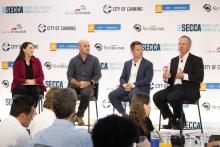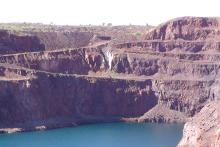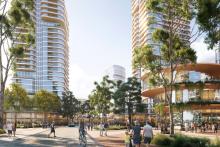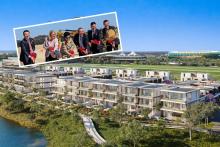The racing industry hoped a land deal at Belmont Park would create a $4 billion precinct, but 10 years later it sits empty.

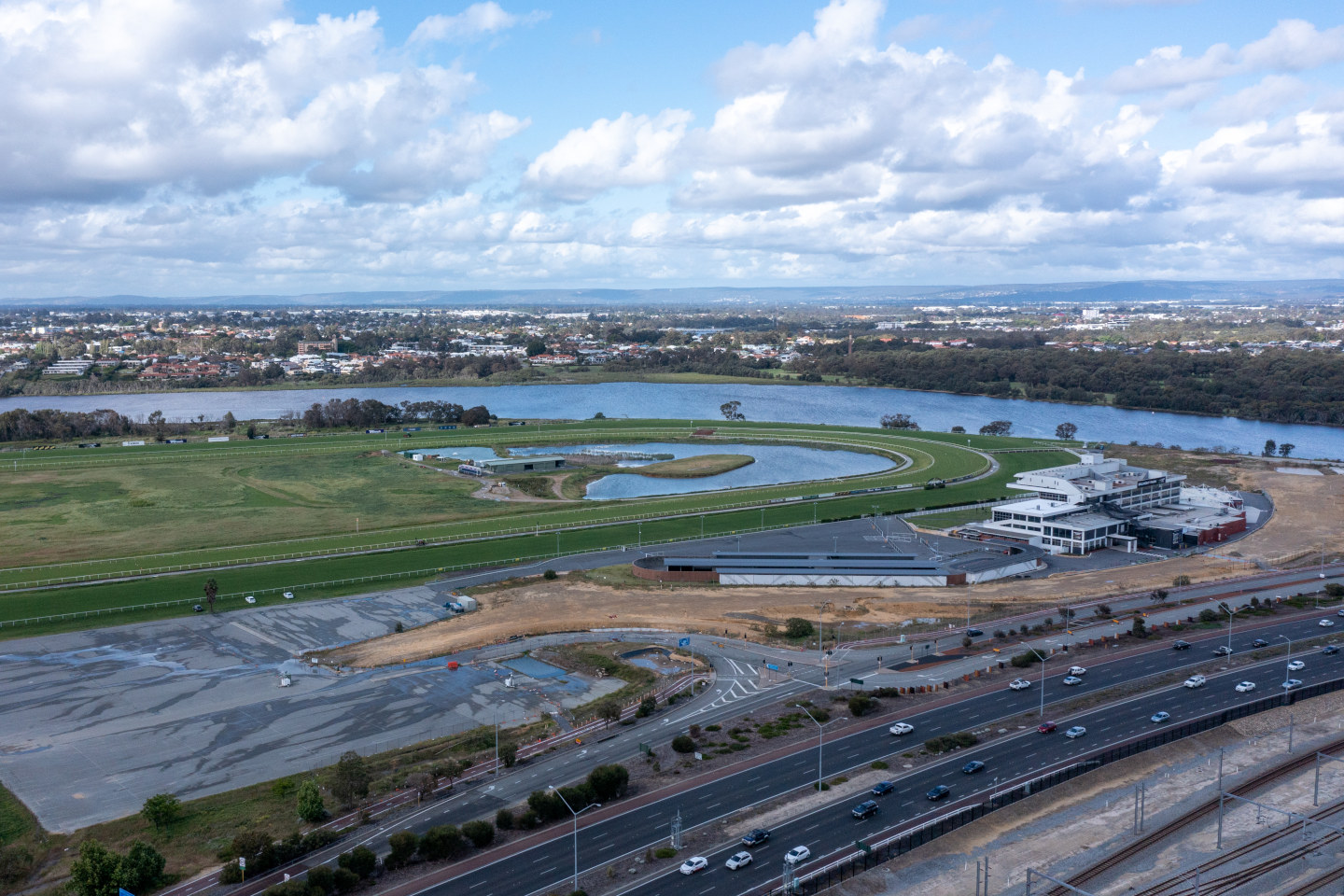
As far as boom time in Perth goes, February 2011 would have been close to the high-water mark.
Iron ore was changing hands at close to $US190 a tonne, while Chevron and Fortescue Metals Group both reported new resource discoveries, near Barrow Island and Cloudbreak respectively.
In a time of big investments, the WA Turf Club, operating as Perth Racing, had its own mega project in mind: a $4 billion redevelopment of the land around its Belmont Park racecourse.
On Tuesday February 8, board members were racing to make a decision on a proposal from Golden Group to buy the 33-hectare site.
The following morning, then premier Colin Barnett was to visit Belmont Park to tour the Magic Millions thoroughbred auction.

Colin Barnett in 2016. Photo: Philip Gostelow
His goal was to secure the land for the new Perth Stadium.
Exactly how the deal might look was open for discussion, although the premier had a few ideas.
In addition to financial compensation, options included granting of freehold title for Perth Racing at the nearby Ascot track (held on a crown lease), and investment into that course.
He was also considering funding an equestrian centre at a new outer metropolitan racecourse, an idea later recommended by consultancy GHD in its 2015 review of horse industry assets.
However the deal might have looked, it was off the table before government representatives arrived to open negotiations that Wednesday morning.
Perth Racing had just signed on to sell the land to Golden Group.
“When I arrived (that morning) ... the chief executive at the time told me they had reached an agreement with the Golden Group to redevelop Belmont Park,” Mr Barnett told Business News.
“They weren’t interested in the stadium going there, that was the end of that.
“I was ok with that, (but) I still felt it was a mistake for racing to have two racecourses within a couple of kilometres of each other.”
He said he had thought horse racing would have benefited from having one excellent quality course at Ascot and an equestrian complex at a new site.
Soon after, surveying work suggested the stadium could instead go on the Burswood Park Golf Course site, its eventual home.
“They basically rejected it before it even got started,” Mr Barnett said, saying he thought the racing industry had missed an opportunity.
“From my point of view, I’m happy with the way the stadium worked out.”
Off track

The race course and surrounds about 10 years ago. Photo: Golden Group

The redevelopment and race course in October. Photo: David Henry
Ten years on, some in the racing industry are asking how much the deal benefited their sport.
All the land was sold to one counterparty and sits undeveloped.
Perth Racing received cash in instalments and will get a cut of revenue from the development, plus financing for upgrades such as an improved grandstand.
The money would help resolve two challenges.
The grandstand at Belmont Park is about 50 years old, with industry members eager to see it upgraded.
Attendance fell by 35 per cent from 2009 financial year to 2019 (see chart).
The long-term trend reflects cultural changes, with racing competing with many more forms of entertainment than ever before.
Lower crowds have a flow-on impact to the key revenue stream of on-course betting, which dropped from nearly $42 million in the 2012 financial year to be $10 million in 2021.
But the 1.1 million square metres of gross floor area planned to be constructed has not yet materialised, with approvals processes, a soft market and COVID-19 causing challenges.
That’s despite a ground-breaking ceremony at the site in May 2018, and a report in Business News as early as 2013 that Golden Group was planning to soon put apartments on the market.
“It’s the best bit of real estate in the country,” one racing veteran told Business News.
“It’s got Optus (Stadium) alongside it now.
“It hasn’t had anything done to it for a number of years.
“Selling the Belmont Park (land) is possibly the worst thing that’s happened in racing in the past 50 years.
“It’s something that’s sent racing backwards.”
Another industry source said signing the deal with Golden Group ahead of the government had created enormous animosity.
Frustrations go beyond the delay.
The land sale was up to the fence line of the track, which affected the ability to set up equipment such as lights outside the perimeter, industry sources have claimed.
Car parking was moved further from the grandstand, causing frustrations because Belmont is intended as a winter track.
Legendary trainer Fred Kersley said the racing industry had been left scratching their heads.
“In terms of the sale, a lot of it remains a mystery to the fraternity,” Mr Kersely said.
“The majority of people are left wondering what happened and why.”
The industry received its first portion of cash from Golden Group on February 10, 2011, the day after the meeting with Mr Barnett.
It was a $2.5 million partly refundable payment, according to its 2012 annual report.
In September 2011, it received $8 million more.
Those numbers were outlined under the “going concern” subsection of the 2012 audited statements, the section which addresses if whether business can trade and pay debts.
It said the club had a net current asset deficiency of $3.4 million at July 2012, and that the Golden Group money had been used to reduce a debt facility with Bankwest.
For that facility, loan covenants required bank debt to not exceed 30 per cent of assets.
Borrowings were at 29.3 per cent of assets when the books were squared off on June 30, 2011.
That ratio is based on borrowings of $11 million at the end of June 2011, including a $6.6 million commercial advance for the Belmont redevelopment.
Assets were booked at cost and were $37.5 million, including an $8.5 million provision for “development work in progress” as a current asset.
But in these early months, there was confidence the project would soon get off the ground.
A letter sent by Golden Group representatives to cabinet ministers in December 2011 said the redevelopment would get under way in 2012.
In Perth Racing’s 2013 annual report, then chair Ted Van Heemst said the approvals for the deal had been completed in May 2013, with the turf club receiving a $51 million payment.
About $11 million was used to reimburse approvals costs, with $40 million banked, to pay for a new grandstand at Belmont Park and improvements at Ascot.
Vision


Golden Group's planned Belmont Park development. Photo: Golden Group
Work on a potential redevelopment at Belmont started in 2003, with about $7 million already spent on planning approvals to 2011, Business News understands.
Four potential parties had each undertaken exclusive due diligence in periods over 18 months, though it had not proceeded.
Golden Group was backed by Indonesian financiers, it is understood.
Mr Van Heemst, who is managing director of Vanguard Press and served as Perth Racing chair for nearly two decades to 2015, said his concept of how Belmont Park should look had not changed.
“The benefit for racing was always, that given that location, that would put us into an international landscape of where we could beam our product,” he said.
“Not only into the same time zone, but into Europe for example, where our product would fill a void (in) the middle of the day.
“It was a multi-faceted opportunity in terms of generating tourism and profile for the state.
“The concept was always to introduce night racing at Belmont Park … running in conjunction with perhaps Singapore.”
It would also target a younger demographic.
He said the build-out value of the project had been estimated at $4 billion, with a 5 per cent return for the turf club, roughly $200 million, which would keep it financially sustainable in the long term.
The first $50 million, which would represent the first $1 billion of built value, was upfront.
“Once it got past the initial deposit, the annuity would start to kick in,” Mr Van Heemst said.
That means sales will need to pass $1 billion for the mechanism to flow.
By contrast, he said he did not expect the state government would offer a long-term vision for the club.
Mr Van Heemst said news reporting in the lead up to the February meeting had been the first he had heard about the potential Belmont stadium site.
“It came at a time when we had pretty much finalised the contract with the Golden Group,” he said
“They were quite keen to sign off, they were quite alarmed when they saw that article.
“The other point about it is, we would not have been happy to get off that site, it’s a premium site.”
He said Golden Group’s original concept had gradually been watered down from a very high-end product.
“At this point in time it’s just got into a gridlock,” Mr Van Heemst said.
“It’s extremely frustrating that nothing (has) happened.”
He said he was also disappointed that an approach to the state government to support a redeveloped grandstand had been knocked back.
Only about $20 million would have been needed to supplement the club’s cash and contractual commitments from Golden Group, he said.
Mr Van Heemst said the bank had not been concerned about the covenants, because the assets were worth more than book value.

Two tracks
A Queen’s Counsel at Albert Wolff Chambers Tom Percy grew up going to the track but said the industry had to accept it had changed substantially since.
“People just don’t go any more, (even) the diehards,” Mr Percy said, noting the rise of televised broadcasting of races.
That raised questions over the need for huge grandstands and resource allocation to what could soon become a cottage industry.
“You can’t cater for crowds that aren’t there,” he said.
“I don’t see how they can continue to charge admission.
“It’s got to the stage you nearly need to pay someone to go to the races.”
He said the industry needed a multi-purpose, multi-code arena, with greyhounds potentially to move from Cannington and trotting (harness racing) from Gloucester Park.
In the years that followed the Belmont Park sale, renowned local dealmaker and Argonaut co-founder Eddie Rigg served a term on Perth Racing’s board.
“Belmont Park was a deal on paper which ultimately looked better than what has happened to date,” Mr Rigg told Business News.
“But over the long term I think it will still be positive.”
Where the contract had perhaps failed was that it lacked a date requiring Golden Group to start work, he said.
The financial modelling showed substantial value to Perth Racing over the long term, he said.
Mr Rigg believes Belmont is the right place for a racetrack.
“If the fairy godmother arrived in Perth and said, ‘where is the best possible place to have a racetrack in Perth’, without doubt it’s Belmont,” he said.
The venue is next to a freeway, has easy rail access and is part of an entertainment precinct, while the shape and land would allow two tracks.
Around 2014, Mr Rigg had advocated to sharpen up Belmont to be a premium racecourse, with a 1,600-metre all-weather racetrack installed in the middle, plus a five- to seven-storey facility, and a new equestrian complex and racing venue in Perth’s south.
Two tracks at Belmont would be important for safety, he said, because Perth had a very substantial number of race meetings and the tracks needed time to recover.
Jandakot was one location which had been considered for a new complex, with space for about 3,000 racegoers.
The venue would have had on-course accommodation for horses and people, food and feed merchants, and training programs for young people.
That would bring substantial benefits, as trainers would not need to keep horses in their backyards and move them to the track, he said.
It would reduce capital needed to enter the industry.
His vision was a centre of excellence for racing, potentially with trotting relocated from Gloucester Park.
Regional tracks would be rationalised so higher investment flowed to locations with stronger attendance.
The plan would have been funded by the then sale process of the TAB and a deal with the state government to launch a residential development on the Ascot site.
Perth Racing could negotiate to vacate a peppercorn 999-year grant giving it rights at Ascot to support that development, which would have been worth more than $200 million.
The TAB deal at that time would have required the private operator to continue funding the industry, which Mr Rigg said would be a far better outcome than relying on consolidated government revenue.
There were also negotiations for a portion of the sale revenue, which could have been $1 billion, to flow to racing.
“Where it works is where the betting operator funds an industry,” Mr Rigg said.
“I’d rather trust a Tabcorp than a government. Governments change.
“It’s in (Tabcorp’s) DNA to support the racing industry.
“Without a vibrant racing industry, they won’t have a business.”
The state government’s October move to reopen the sale process no longer has a provision for ongoing funding and will be subject to negotiation.
The reaction from some in the industry to his vision was unbelievably aggressive, Mr Rigg said, although many had since come around to his position.
“People thought (if) we sell the TAB, we lose our income stream, clearly that’s not what I was advocating,” he said.
There had been threats to harm him and he required dramatically increased security, including a six-month period in which he could not drive to the course because of a potential bomb risk.
Financially, there was a big hit.
Income at his racing stud fell from $1.2 million to about a 10th of that as people stopped buying his horses.
“I was devastated,” Mr Rigg said.
“What I was trying to do was the right thing for the industry.
“Time has shown now the industry was very supportive of what we put together.
“People who were 100 per cent against me are now running petitions.”
Moving forward?

Hassel's October 2019 design.
In October 2019, a Development Assessment Panel gave a three-year approval for the first two towers to be built in the south-east corner of the site, precinct D.
Hassell had been the architect for that $205 million project.
Business News understands forward works are planned to start in January, civil in September 2022, a relocation of the 1,000-metre racing chute in October and built-form development in January 2023.
Subiaco-based Civcon won a 2018 contract for the first stage of works and was on site for 18 months prior to the pandemic crisis.
Completed work included demolishing existing structures and roads, sewer works, a retaining wall and 50 per cent of earthworks.
Contractors for Water Corporation have recently been on site constructing a new pipeline, unrelated to the development.

Andrew Sugiaputra in 2015. Photo: Attila Csaszar
Golden Group managing director Andrew Sugiaputra said the company would be restarting work in precinct D, and had recently submitted a plan for the north-west corner, precinct A.
The Town of Victoria Park is assessing that plan.
Mr Sugiaputra said the project had been delayed by approval timelines, a period of softness in the Perth property market and COVID-19.
But proof of the company’s intent would be seen in the next year.
“I’m for team WA,” Mr Sugiaputra said.
“This is not a one or two-tower development, it is multiple stages.
“To give a perspective, precinct B is the size of Elizabeth Quay.
“It’s easy for people who don’t understand development to be … critical.
“The sheer scale and complexity of the project makes it more challenging than a one or two-tower development in the suburbs or in the city.”
After the ground-breaking in 2018, he said the company had been committed to start work on infrastructure at the site.

A rendering of Precinct A. Photo: Golden Group
He pointed to Golden Group’s developments proceeding in other locations, including the Golden Square refurbishment in the city.
“(For my team members) this is the most challenging project in their careers, some of the guys have 25 years on me in their experience,” Mr Sugiaputra said.
One industry source suggested the Foreign Investment Review Board had scope to intervene because of the delays.
FIRB approved the deal in 2013 after changes to the structure, and a document sighted by Business News suggested the approval was contingent on substantial commencement of construction within five years.
When asked, Mr Sugiaputra said the company was compliant with the FIRB ruling.
Business News also understands another deal was offered in around 2015, with a Chinese investor to buy the land for about $160 million.
“The land was never up for sale,” Mr Sugiaputra said.
He said the value of the land had improved after the Crown Towers redevelopment and the stadium.
“When we bought it, some people came up to me and asked why we bought the land,” he said.
But he also said the project getting into construction would benefit both Golden Group and Perth Racing.
“The faster we pay them, the happier everyone will be, including ourselves,” he said.
“Everyone’s in the same boat in that.”

The Belmont Park grandstand. Photo: Matt Mckenzie
Perth Racing chair Colin Brown said the board’s focus was maximising opportunities now.
“Nothing we do is ever going to change the decision made a decade ago,” Mr Brown said.
“I’m sure the committee at the time had gone through the data presented and in their minds were making the right call.”
Discussions with Golden Group now were very positive, Mr Brown said, including proposed dates.
“I’m as confident as I can be that something is going to happen,” he said.
That was evidenced by the two parties negotiating on fine details such as the relocation of the 1,000-metre racing chute to make way for precinct A.
Belmont and Ascot both offered something in the medium term, with Belmont a boutique option in a beautiful location, he said.
Work with Racing and Wagering Western Australia had supported improvements at Belmont to move meetings between tracks outside of their usual summer and winter seasons.
There had been investments into new bars, and jockeys and stewards’ rooms at the course, too.
Improving the grandstand, a top concern among racing aficionados, was also a high priority.
“I don’t think there’s a person on the planet who wouldn’t like to see a new grandstand,” Mr Brown said.
To fund that, Perth Racing would look to develop a proposal which could have multi-use benefits.
“If we can get everything together, it’s going to be a fantastic racecourse,” he said.










